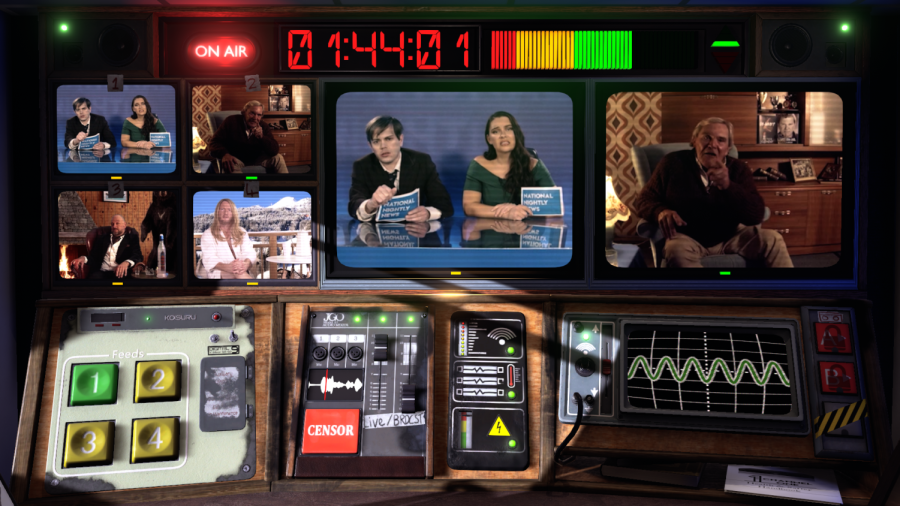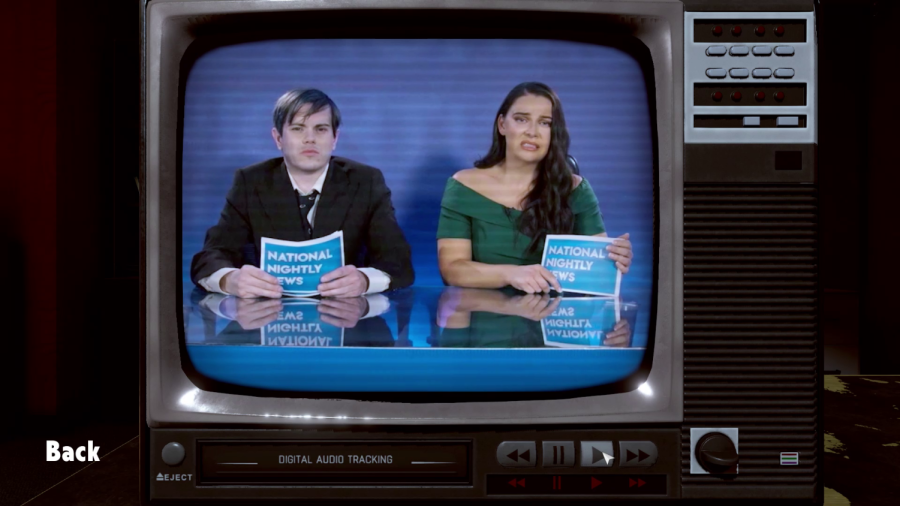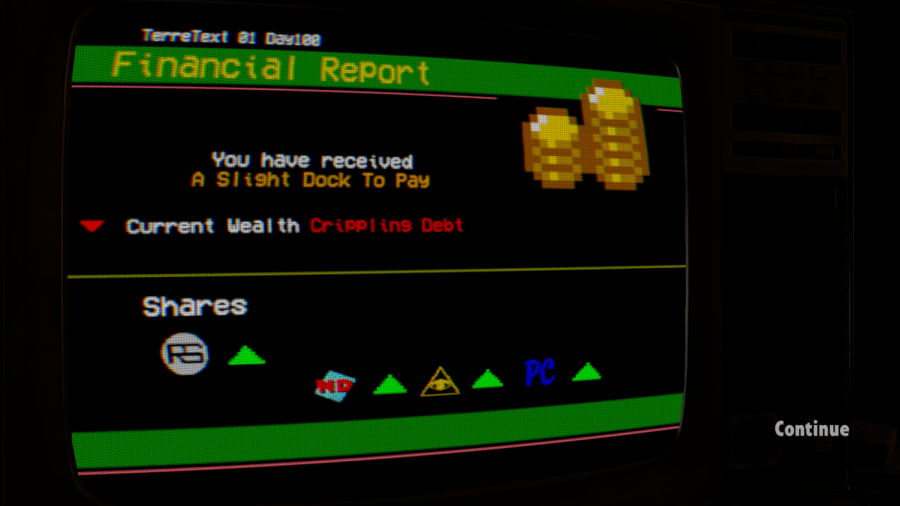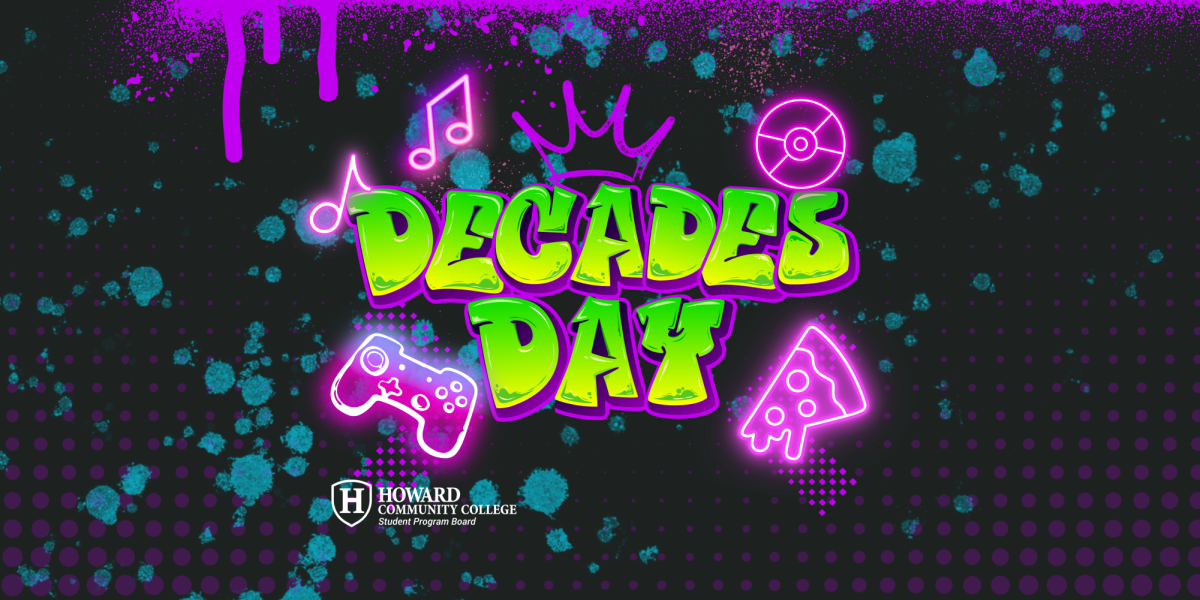“Not for Broadcast” Review
Ready for Primetime
News anchors Jeremy Donaldson (Paul Baverstock) and Megan Wolfe (Andrea Valls) announcing the day’s news.
February 1, 2023
Lights flash on. You’re airing. Quickly you flash between feeds and move signals to get the message out. That is, after all, your job at the news—to get the message, and the truth, out there. But whose truth is it? Is it the government’s, as they bear down more and more on you? Or is it the rebels, who claim to be fighting for “freedom.” But from what? Or, more disturbingly, for who? Is it some outside force that’s manipulating you to choose what is the “truth,” or in the end, are you pulling your own strings for them without even knowing? And in the end, is it right that you alone decide the truth of the matter?
“Not for Broadcast” doesn’t offer any clear answers for this, but it does ask us, at the very least, to be smart about it. Developed by NotGames as their first major release and published by tinyBuild, “Not for Broadcast” is best described as a dystopic media simulator. The game was originally put into early access in early 2020, and has been steadily worked on even through the pandemic to see its final release in January of last year.
Now seems like a perfect time to review the game. Not only does it see its one year anniversary pass while this review releases with an recent announcement of upcoming new content, but, as The HCC Times returns from winter break, what better time to bring it back than with a review about a game that pays tribute to the importance of the Fourth Estate?
“Not for Broadcast” takes place in an unnamed yet undoubtedly Britain-like country in an alternate 1984. Following a scandal which rocked the country earlier in the year, an election leads the radical Advance party—which rallied on a platform of sweeping reform on wealth distribution and welfare—to take over in a landslide. You are Alex Winston, a janitor-turned-broadcast engineer of purposefully ambiguous gender with a family who works at the country’s most trusted news program, the National Nightly News. After being given the job after election day by the previous engineer, who fled the country to escape the incoming government, you are tasked with managing the broadcast room, maintaining the feed and making choices for headlines and ads as you go. It’s a relatively simple yet hectic job, as you perform on-the-fly editing while dealing with wacky people and topics on the news. As you get settled in, however, you find that your newfound position may prove to have more responsibilities than you had expected, especially as conflict in the country under the new government pile up, and Advance seems to be more and more watchful over what you put on the air.

The gameplay, as best as I can oversimplify it, is like a cross between elements of “Night Trap,” “Five Nights at Freddy’s” and “Papers, Please,” in a way that hopefully isn’t as chaotic or off-putting as that all sounds. The game focuses on broadcast segments, which place you in the broadcast room with a panel of intimidating controls and screens. You have up to four screens of live camera feeds which you can cut to, filmed with live actors as full motion video, or FMV, which you can cut between to form the broadcast feed that will be shown to viewers. The aim of each broadcast is not only to ensure that the show goes on, but that you maintain the viewers’ interest. Besides staying on whoever is talking, the player will also have to vary the shots so they don’t stay on one person for too long, lest it becomes too “boring,” such as cutting to someone’s reaction or a wide shot. They will also need to be careful not to cut between shots too quickly, or accidentally cut to something they shouldn’t have.
Complicating this are host of other issues that can arise out of the blue which the player needs to deal with immediately, such as foul language that needs to be censored or “signal disturbances” which require the player to stretch and shift the signal wavelength to match. There are several segments where the player has to “cut to the beat” of the music, maintaining a combo multiplier on audience interest in the process. Unique “broadcast difficulties” appear in some segments too, requiring you to keep on top of yet another issue, like circuit breakers that will overheat and cause you to lose power unless you angle a shoddy fan onto them to cool them down, or electrified buttons that will shock the player and result in a game over if too many shocks are taken at once.
At the end of each broadcast, wages will be given depending on the quality of broadcast, which affect your wealth and affect wider aspects of the game. In between all of this chaos, the player has to make editorial and personal choices during the broadcast and in text-based “home” segments between broadcasts, influencing the characters and public and in turn placing the fate of them, your family and the entire country into your hands. These can be in critical moments, like choosing which headline to pick or whether to give your passport to a brother-in-law, or they can be more subtle, such as your judgement on whether to censor statements that Advance “advises” you to or not, or which advertisements to play between breaks. You can attempt to focus on your family or which faction you support or just whatever you feel is right in the moment, with a number of unseen consequences to each, regardless of the intentions.

What you get is a game that keeps you constantly on your toes like a mental game of Twister, as you have to run around between buttons and panels to ensure that the broadcast runs smoothly, while also asking you to make big or tough choices with consideration to their ramifications. And it’s fun.
The controls may take some time to get used to, given that you can either interact with the panel buttons within the game with the click of a mouse or use keys on a keyboard. While I personally came to mostly use the keyboard with some mouse use, the game offers plenty of options to change the controls, including the use of a gamepad or other devices. However you play, once you get a handle on things, the game becomes hectic yet exhilarating , jumping from issue to issue as you try to keep the whole show from falling apart. The game tests your skills when it comes to multi-tasking and perception, as you’ll often need to keep your eyes, fingers and even ears on task to cut away at the right time or censor at the right moment or deal with an issue in the broadcast room—sometimes at the same time. While that could easily turn into an overwhelming mess, the game is fair in how it doles out these tasks. There is typically only one task that needs to be handled on a moment-to-moment basis, and very rarely does the game prompt you to complete more than two tasks at once. While it can get repetitive, it still by and large remains a fun time throughout. Managing to perfect an edit and get and A+ score can be so satisfying to pull off and see, and the option to look back at how your broadcasts went also provides a chance to admire—or wince—at your skills.
If this sounds too daunting or somehow too simple, the game offers numerous difficulty options for all players. This ranges from a “story mode” where players can coast along without having to worry about their editing abilities, all the way to a “hardcore mode” where players are left without an audience engagement meter to tell whether they’re even doing a good job. The “Challenge Room” mode also gives players more to do after the story as they go through broadcasts with extreme versions of these gimmicks like overheating circuits or signal interference, coming faster, more frequent and in the face of a fickler audience.
This gameplay was what first drew me to the game when I learned of it, with its story coming second. And while the gameplay more than satisfied, I was also shocked by how well the story itself developed, and how much it engaged me.
The world of the National Nightly News covers a cavalcade of silly characters and topics across its time on air, from the advertiser “Crazy Neil,” whose greenscreen appearances laden with gaudy editing akin to something Adult Swim would air at 3am, to the nonsensical “new national sport” Sportsboard, which appears to have no set or sensible rules. Yet while it could easily fall from satire into the realm of being a complete farce, the game isn’t afraid to delve into seriousness, especially as the game goes on, and manages to do so masterfully. From the ridiculous circumstances of one character interviewing a group of people with ridiculous conditions, including a person whose “bowels have comic timing,” the scene is made more darkly humorous yet insidious with the grimacing interviewer, clearly feeling demeaned by this government-mandated coverage as more pressing issues mount, who is forced to grin and bear his guests. It’s hilarious, yet tragic, and made all the more unfortunate as the show rolls on.
All of this runs with themes of the classic freedom versus security debate and how media portrays truth. The game could have easily gone with a “government bad, rebels bad” plot, but instead it adds shades of gray to the factions and issues and asks you to look beyond the stark coat put up by each side. Though Advance’s grip on life and freedoms becomes ever tighter, and some of their means of retaining power become increasingly harsh, their policies are shown to be very effective in bettering people’s lives, and they genuinely intend to keep the people’s best interests in mind. While the rebellious group Disrupt touts freedom for all, is the potential inequality and insecurity that is associated with their freedom all it’s cracked up to be? And in either case, is there more to the picture than we are given?
The game leaves questions about the broader issues these relate to unanswered, as they are in real life, but tells us that we certainly don’t need to fall into the extremes. More importantly, it tells us that there can be a middle ground and consensus about these, and to be wary of falling into one single view of a topic, regardless of what it is. It’s a worthy message in these times of social media bubbles, asking us to consider our own positions on these platforms where, much like Alex Winston, we can influence the debate as much as it influences us, and where we are left wondering whether or not we really have a grip on the story or the consequences.

While I adore the story, I have to admit its production can be wanting at times. This isn’t to downplay the effort or say that it’s all dismal. The performances by the actors are stellar, with characters like frustrated news anchor Jeremy Donaldson (Paul Baverstock) or media-savvy prime minister Julia Salisbury (Claire Racklyeft) being especially worthy of praise. Graphics are also fairly decent, if perhaps not to snuff with other titles, and the music can be a great and funny listen. However, some other production elements, both within the FMV segments and in the game itself, can appear rather cheap. Many adverts and headlines use overly simplistic, low-quality imagery that distracted from gameplay. The “home” segments as well, while excellently written, are dampened by how they are almost exclusively given in text boxes with relevant images and music. Of course, part of that could be explained as a result of Alex and their partner, Sam, having their genders and appearance be deliberately vague in order to be universal to the player. Likewise, the other production choices can often be understood or explained as either being part of the game’s humor, the time period or the game’s budget and circumstances of development. Still, I can’t help but think that some elements could have been touched up more to better resemble a professional broadcast, though it’s only a minor issue.
What would be a more concerning point, depending on the player, is the game’s length. At around 8 to 10 hours for a single playthrough, the game is fairly short. While the base price of $25 is not the worst, it can be iffy for some, especially as there are current games that are priced more affordably while offering several times the length on a single playthrough. Of course, this factor is tempered with the game’s replay, as it encourages players to perform new runs, not only to get a higher rating on each broadcast or attempt on some harder difficulty, but also to gain new endings and footage to watch as a result of their choices, alongside the aforementioned challenge room to really push one’s skills. And with some 42 hours of FMV within the game—a world record, in fact―there will be plenty to find with each new run of the game.
Given the alternate perspectives offered with each ending and what I find to be satisfying arcade-like gameplay, I find the amount of content offered by the game to be worthwhile. However, playing through, even with different choices, can sometimes result in similar or the same footage appearing, meaning that on several runs, players may end up having to hear the same songs or view the same footage. The exhaustion from this only occurs if you choose to play “Not for Broadcast” to essentially 100% completion across several straight gaming sessions, which most sane people won’t ever willing to do. Even attempting just a few runs for different endings and perfection can net someone a great many hours of gameplay for its regular $25 price. However, I would still imagine the price point to generate varying levels of satisfaction from person-to-person, depending on their tastes and their tolerance for experiencing the same footage.
Nevertheless, “Not for Broadcast” is a fantastic achievement, striking a rare balance between gameplay and storytelling and offering a smart yet entertaining message with it. While it’s not the easiest to jump into, it’s ultimately a remarkable labor of love from the developers. And with the game’s anniversary seeing announcements for DLC and releases on console and even a VR version, it’s sure to be a game many will keep tuning into.
“Not for Broadcast” is currently available on Windows PCs on all major video game distribution services, including Steam, GOG and the Epic Games Store, with a free demo available. Console ports for PlayStation and Xbox will also arrive on March 23.








